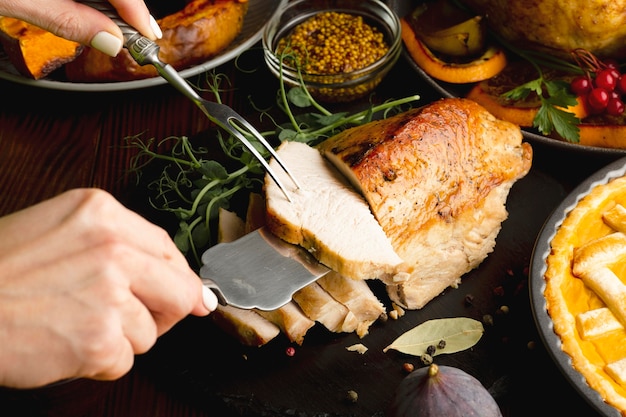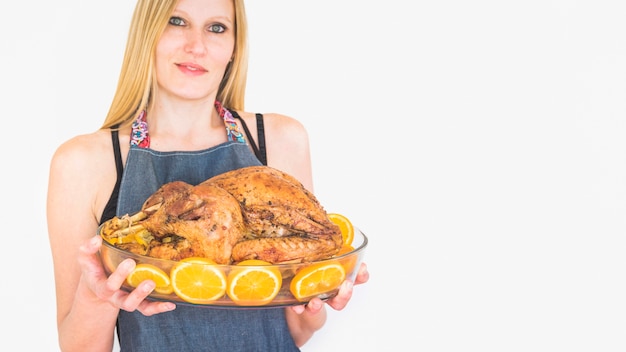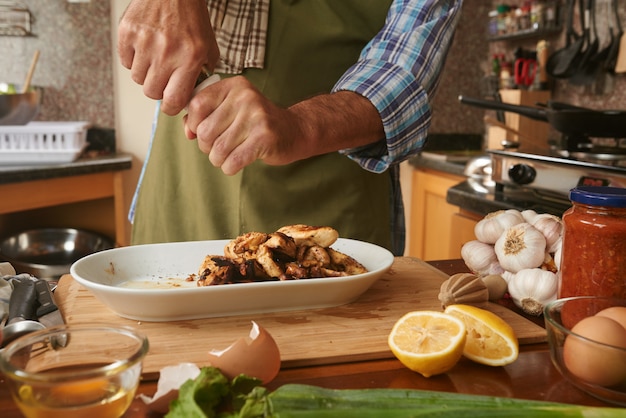(Part 1) Understanding the Basics

I've been cooking for years, and I've made my fair share of chicken mishaps. Dry, tough breasts? Check. Raw bits hiding in the middle? Been there, done that. I've learned the hard way that cooking chicken isn't just about tossing it in a pan. It's about understanding how heat affects the meat, how to gauge its doneness, and knowing which methods work best for different cuts.
The Importance of Temperature
Let's start with the big one: temperature. We all know the drill: food safety. The USDA says cook chicken to 165°F (74°C) internally to kill off those pesky bacteria. And trust me, I'm all for that. Nobody wants a bout of food poisoning. But hitting that temperature doesn't guarantee a perfectly cooked chicken. You want that tender, juicy texture, right? That’s where the real skill comes in.
The Anatomy of Chicken
First, we need to understand the different cuts. chicken breasts, thighs, wings, drumsticks, even whole birds – each has its own personality. Think about it – a thick, juicy thigh needs a different approach than a thin, delicate breast, right?
(Part 2) chicken cooking methods: A Quick Guide

Now, let’s delve into the cooking methods. There's a whole world of ways to cook chicken, and the right method can make all the difference in achieving that perfect texture.
Roasting: A Classic Choice
For a whole chicken or larger pieces, roasting is a classic for a reason. It’s simple, hands-off, and allows the chicken to cook evenly. I usually roast my bird at 375°F (190°C) for about 1.5 to 2 hours, depending on size. Before popping it in, give it a good rub with herbs and spices – I love rosemary, thyme, and garlic – and a drizzle of olive oil to help lock in moisture.
Pan-Frying: For a Golden Crust
Pan-frying is ideal for chicken breasts, thighs, or even wings. You want a good quality pan that gets nice and hot, and a little bit of oil. I find it helps to season the chicken with salt and pepper before searing it on both sides for about 4-5 minutes per side. This creates that beautiful, golden crust. Then, reduce the heat, cover the pan, and cook it through. Don’t forget to deglaze the pan with a splash of wine or broth for extra flavour.
Grilling: Summertime Delight
Ah, grilled chicken – the taste of summer. Chicken breasts and thighs are perfect for the grill. Preheating to medium-high heat is key. Invest in a good meat thermometer if you’re serious about grilling chicken; it’s easy to overcook it on the grill.
Baking: For a Moist and Tender Outcome
baking chicken is a simple way to get a juicy, tender result. Placing the chicken on a rack over a baking sheet allows for even cooking and air circulation, preventing soggy skin. Bake at a slightly lower temperature, around 350°F (175°C). It might take a bit longer, but the result is well worth the wait.
(Part 3) chicken cooking times: A Detailed Breakdown

Alright, let's get into the nitty-gritty: cooking times. A meat thermometer is your new best friend here; no more guessing!
Chicken Breast
Chicken breasts are versatile, but they can easily dry out if overcooked. For a standard-sized breast, I aim for 15-20 minutes at 375°F (190°C). For smaller breasts, reduce the time to around 10 minutes. Pan-frying takes about 5 minutes per side for a medium-sized breast. Remember, it’s better to undercook slightly, as you can always pop it back in the oven for a few minutes if needed.
chicken thighs
Chicken thighs are known for being juicy and flavorful. They’re more forgiving than breasts when it comes to cooking time. For a bone-in thigh, roast it at 375°F (190°C) for 30-40 minutes, depending on size. A boneless thigh will take a bit less, around 25-30 minutes. Again, that trusty meat thermometer is your friend.
chicken wings
Chicken wings – the party snack that's tricky to perfect. Baking in the oven at 400°F (200°C) for about 45 minutes, flipping halfway through, gives you nice crispy skin. If you want them even crispier, broil for a few minutes at the end.
chicken drumsticks
Chicken drumsticks – another juicy cut great for roasting or grilling. They need more time than breasts or thighs. I usually aim for 45-60 minutes at 375°F (190°C). For a good roast chicken, cook it until the drumsticks are tender and the juices run clear.
Whole Chicken
The big one: a whole chicken. For a standard 4-5 pound bird, roast it at 375°F (190°C) for about 1 hour and 30 minutes to 2 hours, or until a meat thermometer inserted into the thickest part of the thigh registers 165°F (74°C). Remember, you can always add time if it needs a bit extra.
(Part 4) Cooking Chicken: Tips for Success
So, you’ve got the basics down. But there are a few extra tips to elevate your chicken game.
The Magic of Brining
Let's talk about brining! It’s a real game-changer. Think of it as a spa treatment for your chicken. It involves immersing it in a salt-water solution for a few hours before cooking. Brining helps retain moisture, preventing dryness. You can use a simple salt and water brine, or add herbs and spices for extra flavour.
Don't Overcrowd the Pan
This is a common mistake, especially when you’re cooking a lot of chicken. Give each piece enough space to cook evenly and develop a nice crust. If you’re using a skillet, you might need to cook in batches.
Resting is Key
Once your chicken is cooked, don’t rush to carve it. Let it rest for about 10 minutes before carving. This allows the juices to redistribute, making it more tender and flavorful.
Don't Be Afraid to Experiment
Don’t be afraid to experiment with different marinades, rubs, and sauces. Get creative with your chicken recipes and explore new flavours.
(Part 5) Chicken Cooking Times: Factors to Consider
Remember, the cooking times I’ve outlined are just guidelines. They can vary depending on a few factors.
Size Matters
The size of the chicken piece will affect cooking time. A smaller breast will cook faster than a large one.
Oven Temperature
Make sure your oven is preheated to the correct temperature. If your oven is running hot or cold, it can affect cooking times.
Chicken Density
Different types of chicken have varying densities. For example, a free-range chicken might be a bit denser than a supermarket chicken, so it might take a bit longer to cook.
(Part 6) Chicken Cooking: How to Tell if it's Done
It's essential to be able to tell if chicken is cooked through without cutting into it and risking contamination.
The Finger Test
This is an older trick, but still useful. Press gently on the thickest part of the chicken. If it feels firm to the touch and the juices run clear, it’s likely cooked.
The Meat Thermometer
This is the most reliable way to tell if your chicken is done. Insert the thermometer into the thickest part of the meat, avoiding any bones, and make sure it reaches 165°F (74°C).
(Part 7) Chicken Cooking: Common Mistakes to Avoid
Okay, we’ve talked about all the things you should do, but let’s quickly cover the mistakes we all make from time to time.
Overcrowding the Pan
Remember that overcrowding the pan can lead to uneven cooking and steaming rather than browning.
Not Resting the Chicken
This is a common mistake. Allowing the chicken to rest for 10 minutes after cooking prevents the juices from running out when you carve it.
Not Using a Meat Thermometer
This is the biggest mistake! It’s a cheap investment that can save you from a lot of food poisoning and frustration.
(Part 8) Chicken Cooking: Creative Recipes
Now, let’s move on to some delicious recipe ideas.
Roast Chicken with Lemon and Herbs
This is a classic and flavorful roast chicken recipe. Rub a whole chicken with lemon zest, fresh herbs like rosemary and thyme, and a little olive oil, then roast until cooked through. It’s perfect served with roasted vegetables.
Chicken Stir-Fry
Chicken stir-fry is a quick and easy weeknight dinner. Stir-fry chicken with your favorite vegetables and a flavorful sauce. Try it with soy sauce, ginger, and garlic for a classic stir-fry.
chicken tenders with Honey Mustard Sauce
Chicken tenders are a popular snack or meal for kids. You can bake or fry them and then serve them with a sweet and tangy honey mustard sauce.
Chicken Parmesan
Chicken Parmesan is a classic Italian dish. Bread chicken breasts, then bake them with tomato sauce and melted mozzarella cheese.
Chicken Curry
Chicken curry is a flavorful and aromatic dish that’s great for a family meal. Simmer chicken in a creamy curry sauce with vegetables, spices, and coconut milk.
(Part 9) FAQs
You’re probably wondering about a few specific things.
Q: What if my chicken is overcooked?
Unfortunately, overcooked chicken is usually dry and tough. There’s not much you can do about it once it’s overcooked. Next time, be sure to cook it for a shorter amount of time and use a meat thermometer to ensure it’s cooked through.
Q: Can I cook chicken from frozen?
It’s not recommended to cook chicken from frozen. It’s best to thaw it completely in the refrigerator before cooking. This ensures that it’s cooked evenly and safely.
Q: Can I use leftover cooked chicken in a recipe?
Absolutely! Leftover cooked chicken is perfect for using in salads, soups, sandwiches, or stir-fries.
Q: Can I cook chicken on a lower heat?
Yes, you can. Cooking chicken on a lower heat will take longer, but it can help prevent it from drying out.
Q: How long can I keep cooked chicken in the fridge?
Cooked chicken can be stored in the refrigerator for 3-4 days. Make sure to refrigerate it promptly after cooking.
(Part 10) Conclusion
So, there you have it, my friends! The ins and outs of cooking chicken to perfection. With a little practice and these tips, you'll be creating juicy, tender, and flavorful chicken dishes in no time. Remember, the key is to understand the different cooking methods, keep an eye on the temperature, and most importantly, don’t be afraid to experiment! Enjoy your delicious chicken!
Everyone is watching

Prime Rib Roast Cooking Time Chart: Per Pound Guide
Cooking TipsPrime rib roast. Just the name conjures images of lavish dinners, crackling fires, and hearty laughter. It’s ...

How Long to Bake Potatoes in the Oven (Perfect Every Time)
Cooking TipsBaked potatoes are a staple in my kitchen. They're incredibly versatile, delicious, and surprisingly easy to m...

Perfect Rice Every Time: The Ultimate Guide to Cooking Rice
Cooking TipsAs a self-proclaimed foodie, I've always been a bit obsessed with rice. It's the foundation of countless cuisi...

The Ultimate Guide to Cooking Asparagus: Tips, Techniques, and Recipes
Cooking TipsAsparagus. The mere mention of this spring delicacy conjures up images of vibrant green spears, crisp and burs...

Ultimate Guide to Cooking the Perfect Thanksgiving Turkey
Cooking TipsThanksgiving. Just the word conjures up images of overflowing tables laden with delicious food, the scent of r...
